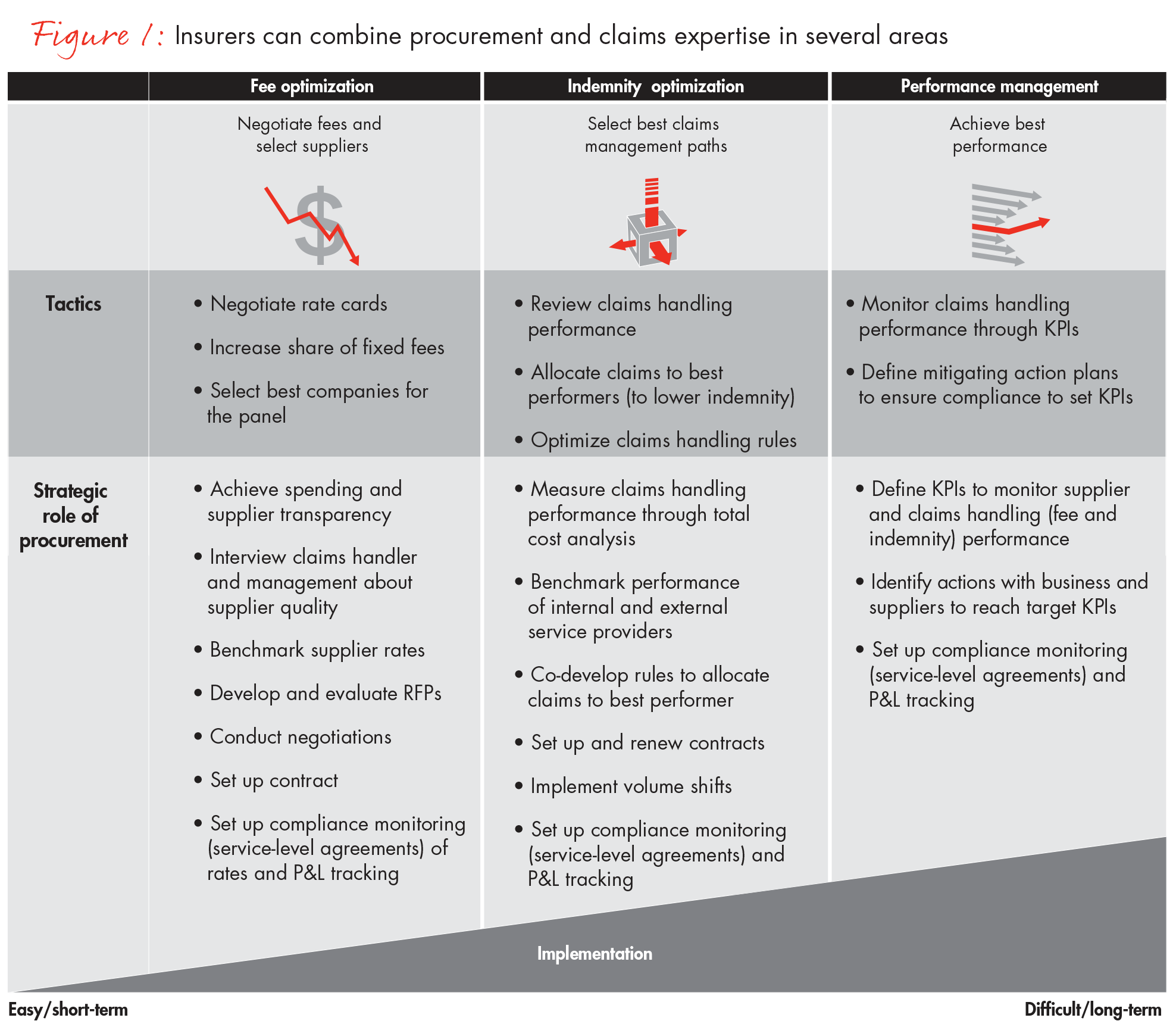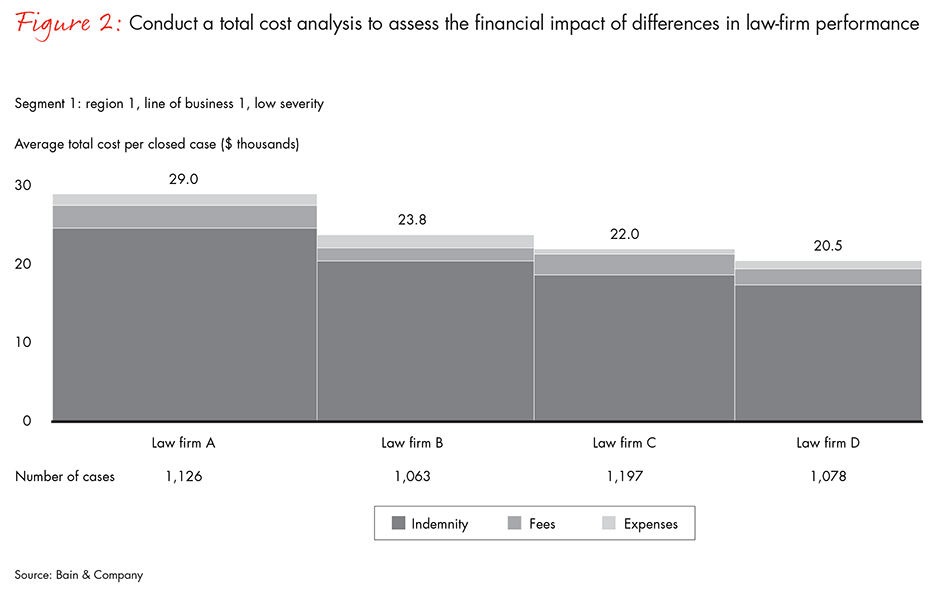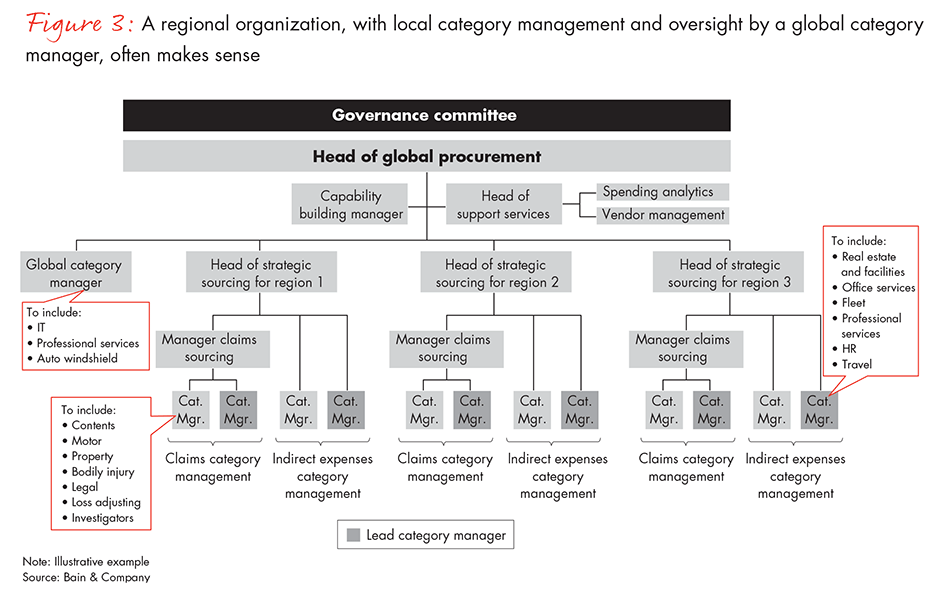Brief

Insurance companies face increased pressure from investors to demonstrate that they can grow while controlling costs. Claims handling, a historically undermanaged area, deserves a new look. Given the low priority assigned to claims handling in the past, many insurers face a capabilities gap: Category strategies do not exist, and fewer than two-thirds of claims are fully transparent to insurers’ own staff.
A broader, more strategic approach to claims procurement allows insurers to make step-change improvements. The most advanced procurement functions add substantial value by becoming strategic partners with claims organizations. For instance, they might jointly choose the most suitable loss adjusters.
One global property and casualty (P&C) insurer based in the Asia-Pacific region optimized its claims management substantially through this approach, reducing fees and indemnity spending by about 7% per year. Investors rewarded these improvements with a higher valuation of the business.
The virtues of collaboration
Procurement has long been viewed as a back-office function that mostly pushes purchase orders. Yet nearly all of benefits come from embedding procurement in claims management at the beginning of the process, especially for large categories such as medical providers, loss adjusters and repairers.
Because the procurement and claims functions bring different expertise to the table, insurers realize major benefits from close collaboration:
- reduced fees, with rates at competitive levels relative to other insurers;
- optimized payouts that are appropriate for the claim amount; and
- higher customer satisfaction and advocacy.
Combining procurement and claims expertise in several areas and throughout the claims episode gives insurers an advantage (see Figure 1). For example, the two functions can work together to be more systematic and rigorous about selecting vendors and negotiating fees. In demand control, compliance and allocating claims volumes to different vendors, they can identify the best-performing firms and define rules to assign cases. Finally, they can rigorously track vendors’ performance to ensure consistent results over the contract period.

Optimizing claims legal services
Claims legal services presents one of the most attractive categories for cost optimization. The spending level is high, including not only law firm fees and expenses (15% of spending), but also the related indemnity payments influenced by law firms (85% of spending). In our experience, insurers can achieve a 10% to 20% savings.
Best-in-class insurers set up a joint claims and procurement approach as basis for success. They then conduct a detailed supplier due diligence, which includes deriving a supplier score and conducting a total cost analysis (TCA). The supplier score integrates several streams of information, such as claims handler interviews and supplier presentations. Incumbent and potential new law firms are rated on a numeric scale and on different dimensions, such as expertise, customer satisfaction, innovation, strategic partnership and financial stability.
The TCA assesses financial performance of law firms in like-for-like segments, such as auto liability claims with low severity in rural Texas. Typical criteria include location, case type and severity. Insurers derive the average total cost per claim, including fees, expenses and indemnity payments per law firm in those comparable segments (see Figure 2).

In the next phase, the procurement and claims groups work together to conduct a well-orchestrated negotiation process and agree on a selection of suppliers. These negotiations aim not only to improve pricing levels and schemes, such as moving to fixed prices for certain segments or introducing new incentives, but also to build strategic partnerships. Procurement, together with the business stakeholders, should develop a detailed plan covering negotiation strategy, risk assessment, communications and negotiation meeting agendas.
The combined rigor of the TCA, supplier scores and negotiations equips insurers to make an objective decision on a final panel setup that will deliver significant financial benefits and high-quality services. The final panel will comprise law firms that have proven that they offer the best value, and each will be used for different segments.
An Australian insurer’s review of a panel for one of its businesses enabled the company to reduce the number of law firms from 15 to 10, from which subpanels were formed for each line of business. The insurer reduced spending by 20%, even as it increased the supplier score by selecting the best performers.
Finally, best in-class insurers continually manage the selected law firms. This includes data-driven performance monitoring, as well as experience sharing between law firms and claims handlers, in order to improve claims handling and reduce the total cost per claim.
Making deft use of third-party administrators in auto insurance
Auto claims management can yield up to 20% savings when the business and procurement group undertake a joint approach to optimize fees and indemnity for the many cases that can be standardized.
Sourced services range from outsourcing the full claims handling process with third-party administrators (TPAs) to negotiating contracts with providers along each step in the value chain, from assessors to body shop networks, parts providers and rental car agencies.
TPAs handle motor claims from end to end and have a major effect on the cost of repair and on customer experience. In the case of an accident, they are the main contact for policyholders and thus have a big influence on customers’ perceptions of the insurer.
At the same time, the insurer may face above-average repair costs if the TPA relies on an expensive repair network that takes a day or two longer than the industry average, leading to higher spending on rental cars. In the worst case, this not only raises indemnity cost, but also degrades the customer experience, as the higher price does not guarantee better service.
Despite these challenges, outsourcing auto claims handling can be highly effective. TPAs are better placed than insurers to keep up with process and technological advances, because they handle claims for numerous insurers. They can respond more flexibly to fluctuations in demand for notice of losses. They have greater access to repair networks and staff.
We have seen insurers initially save up to 15% to 20% on fee and indemnity with a TPA, as well as enhance customer experience by choosing a strong performer. Further savings accrue from taking on other steps in the value chain, such as setting up framework agreements with parts and paint distributors and putting in place global contracts for windshields.
Organizing for collaboration
Unlocking value through procurement requires procurement and claims management teams to commit to a close collaboration. Making the procurement function a truly strategic partner with the business removes a burden from the claims team, allowing it to focus on what it does best. It pays for procurement and business teams to get to know the other’s priorities before engaging in a cost-reduction program that may have major business implications. For example, during budgeting and annual business planning, the teams benefit by synchronizing their objectives and delivery timelines.
Leading insurers give organizational clarity to procurement by assigning a chief procurement officer, who reports to the chief financial officer or chief operating officer and builds a strong rapport with the head of claims. Generally, it makes sense to organize procurement by regions (see Figure 3) but have category management take place at a local level, with oversight by a global category manager.
Many insurance firms have overlooked the huge potential to unlock value through a rigorous, collaborative approach. Companies willing to take this approach can realize substantial cost savings, a faster and more streamlined claims management process and more satisfied customers.

Klaus Neuhaus is a partner with Bain & Company based in Düsseldorf. Richard Fleming is a partner based in New York. Gerry Mattios is a principal based in Beijing. Thomas Lagner and Philipp Weiherl are managers based in Munich. They are affiliated with Bain’s Financial Services practice.


